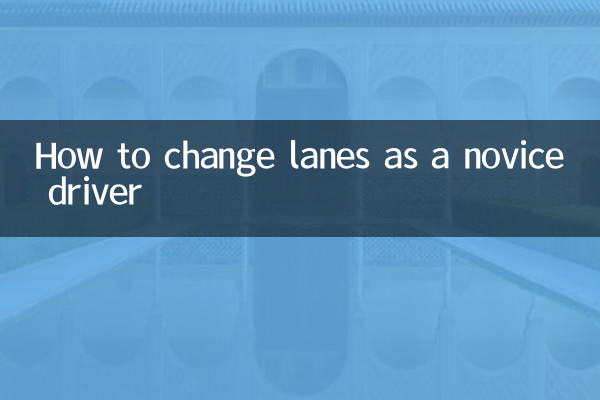How to change lanes as a novice driver
For novice drivers who have just obtained their driver's license, changing lanes is one of the most common operations during driving, but it is also the most likely to cause nervousness or mistakes. This article will combine the hot topics and hot content on the Internet in the past 10 days to provide novice drivers with a detailed lane-changing guide to help everyone complete the lane-changing operation safely and confidently.
1. Preparations before changing lanes

Changing lanes is not simply turning the steering wheel, but requires a series of observations and judgments. Here are the key steps before changing lanes:
| steps | Specific operations | Things to note |
|---|---|---|
| Observe the rearview mirror | Observe the vehicle conditions behind you through the interior rearview mirror and left and right rearview mirrors | Ensure there is sufficient distance and a stable speed for vehicles behind you |
| Check blind spots | Quickly turn your head to check the side and rear blind spots | Pay special attention to small vehicles such as motorcycles |
| Turn on the turn signal | Turn on the turn signal more than 3 seconds in advance | Give clear signals to other vehicles |
2. Operational points when changing lanes
After completing the preparation work, you can start the actual lane changing operation. Here are key tips when changing lanes:
| Skills | Detailed description | Common mistakes |
|---|---|---|
| Smooth steering | Turn the steering wheel in small, gentle motions | Do not make sudden changes in direction or make sharp turns |
| maintain speed | Accelerate slightly or maintain current speed | Avoid sudden deceleration or sudden braking |
| Completed in one go | Complete the lane change decisively without hesitating between lanes | Avoid driving in snakes or changing lanes repeatedly |
3. Lane changing skills under special road conditions
On urban roads, we often encounter some special lane changing situations. For these situations, special attention needs to be paid:
| scene | Coping methods | Danger point |
|---|---|---|
| Congested road section | Plan your route in advance and wait patiently for opportunities to change lanes | Forcibly changing lanes may cause accidents |
| High speed lane change | Leave a longer distance and pay attention to speed differences | The vehicle behind you may be traveling very fast |
| Lane change at night | Look more carefully and confirm the rear lights | Limited vision makes judgment more difficult |
4. Frequently Asked Questions for New Drivers
Based on recent popular discussions, we have compiled some of the lane-changing issues that novice drivers are most concerned about:
Q: What should I do if the vehicle behind me refuses to give way when changing lanes?
A: Stay patient and wait for the right time. You can try to accelerate slightly to create space for changing lanes. Never force a lane change.
Q: What should I do if I am always nervous when changing lanes?
A: Practice more. First choose a section with less traffic to practice changing lanes. As experience accumulates, tension will naturally lessen.
Q: How to judge the time to change lanes?
A: When you see the complete front of the vehicle behind you in the rearview mirror and the distance gradually increases, it is usually a safe time to change lanes.
5. Lane changing safety data statistics
Finally, let’s look at a set of safety statistics related to lane changes:
| Accident type | Proportion | main reason |
|---|---|---|
| Changing lanes and scratching | 32% | unobserved blind area |
| rear-end collision | 25% | Slow down when changing lanes |
| side collision | 18% | Quick direction |
Summary:
Lane changing is a basic skill of driving, but it requires systematic learning and practice. Novice drivers must develop a standard process of observation, lighting, confirmation, and steering, and gradually build up driving confidence. Remember: safety always comes first. It is better to wait for a green light than to take the risk of forcibly changing lanes. As driving experience accumulates, lane changes will become natural and smooth.

check the details

check the details